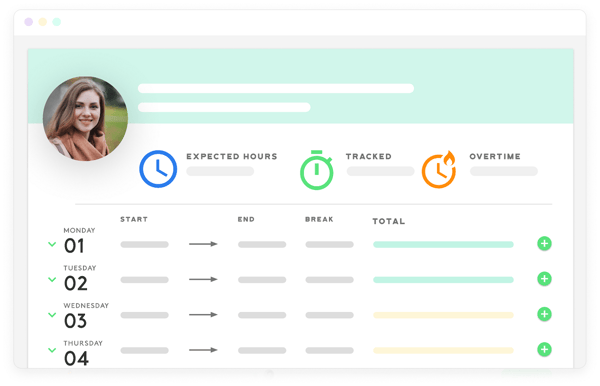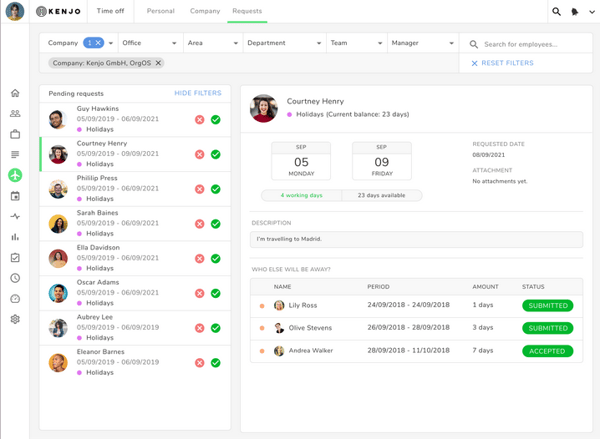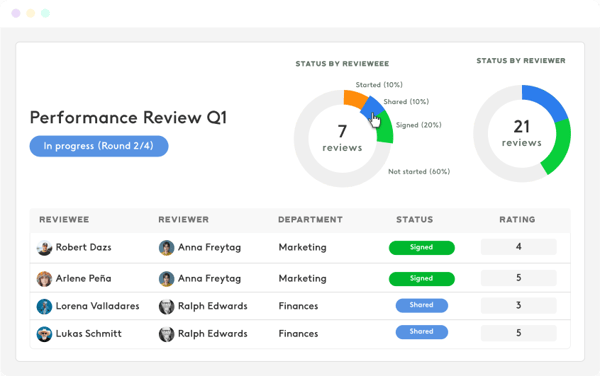The critical role played by healthcare services means that the repercussions of absenteeism in the healthcare industry can be considerable. On one hand, absenteeism affects the healthcare provider, on both a financial and reputational level, and on the other, it generates a tense work environment within teams, which can quickly become overwhelmed by staff shortages.
HR departments need to find new formulas to achieve efficient staff management and avoid concerning levels of absence, and unauthorised absences in particular.
In this article we will explain common causes of this absenteeism, its consequences and how to reduce the rates.
The key data on absenteeism in the healthcare sector
Absence rates in healthcare have been on the rise for a number of years. Data from the NHS show that the sickness absence rates have climbed from 4.21% in 2018/19, to 4.41% in 2019/20, and again to 4.66% in 2020/21. And NHS absence rates are higher than the rest of the economy.
This trend does not look likely to change in the short term, especially with the additional pressures brought about by the Covid-19 pandemic. While significant numbers of staff have been forced to take time off due to infections and self-isolation rules, the virus has also taken its toll on the mental health of many employees, already the leading cause of sickness absence among NHS workers.
In June 2021, for example, anxiety, stress, depression and other psychiatric illnesses were consistently the most reported reason for sickness absence, accounting for over 502,000 full time equivalent days lost and 28.4% of all sickness absence.

The main causes of absenteeism in healthcare
By finding out the reasons why staff do not show up for work, we can try to better understand their needs and offer solutions that match the sector’s particular requirements.
The most relevant causes of absenteeism in healthcare relate to growing workload pressures they have had to cope with and their exposure to Covid-19, a factor that impacts these professionals even more.
The effect of the pandemic
We could not investigate increasing rates of absenteeism without considering the exposure to the virus these employees have to work with daily. In December 2021, The Guardian newspaper reported that according to NHS data, the number of staff days lost to Covid in England the previous week reached 124,855, a 38% increase from the 90,277 total of the week before.
Family reasons
On other occasions, staff need time off from work to care for relatives. When balancing work and family life, especially for professionals with children, it is common to request leave to take on care responsibilities.
Burnout syndrome
The pandemic has been gruelling for healthcare staff. They have seen their workplaces collapse first-hand, with impossible to manage schedules, protocol changes and dissatisfied customers. Without any minimum guarantees in the workplace, professionals can suffer from anxiety, insomnia and even depression.
Force majeure
A force majeure is any event that is considered exceptional, that cannot be prevented or avoided, such as a snowstorm, flood, or even restrictions on movement due to the pandemic. In essence, the reasons for this type of absence make it impossible for the employee to attend their place of work.
The consequences of absenteeism in the healthcare sector
Absenteeism in the health sector has potentially dangerous consequences, including distraction due to lack of sleep, and disorganisation. This can extend waiting times for medical attention and increase costs for the hospital or healthcare provider due to excessive workload pressures.
To guarantee the quality of healthcare provision, for both staff and patients, it is essential to identify the most frequent consequences and put adequate solutions in place. Below, we will run through some of the most common consequences:
Disorganisation
When workers notify their employer that they are not going be at work, or when they simply don’t show up, this impacts the organisation’s general administration, especially everything that relates to shift planning. To be able to resolve this shortage, the HR department must look for a replacement (if there is enough time) or the employee’s colleagues will have to cover the absence themselves.
Demotivation
The emotional burnout that comes with enduring an unstable work environment with a vast workload can make any professional lose motivation. That feeling of conditions outside your control preventing you from doing a good job is frustrating for employees and can make them lose hope of ever providing good service.
Low quality patient care
Everything that goes on internally at a company will end up being noticed by the customer. Staff shortages and needing to make improvised decisions compromise the quality of service provided. These unexpected changes can be interpreted by the customer as a lack of professionalism and integrity. In the healthcare industry this trust is difficult to gain and even harder to recover once lost.
How can technology help to reduce absenteeism?
With technology, we can analyse the causes and consequences of absenteeism, which allows us to connect different variables and in turn improve the rates. Technology supplies the HR department with the full picture, improving visibility of problems in specific areas and helping them make decisions more effectively.
So, using HR software that automates the collection of data on authorised and unauthorised absences, enables leaders to take the lead by implementing changes and reacting in time.

These are some of the functions most commonly used to reduce rates of absenteeism:
Attendance
Attendance is a tool designed to plan work schedules and individual calendars, while workers use it to record their start and finish times and any days they work remotely.
 Kenjo Interface
Kenjo Interface
Holidays and time off
Holidays and time off allows you to view on a single screen all employees who are taking authorised absences, for holidays or leave, and automatically approve requests to streamline the process.
 Kenjo Interface
Kenjo Interface
Staff satisfaction questionnaires
Staff satisfaction questionnaire can prove to be an extremely valuable source of information on your company environment when you are implementing new strategies. They also allow you to provide or receive feedback from workers in order to introduce continuous improvements at the company.
 Kenjo Interface
Kenjo Interface
Performance reviews
Performance reviews are fundamental when it comes to identifying each employee’s potential and the areas they need to improve for continued professional growth.
At Kenjo we know that every company is unique. That’s why we offer a free trial of our software, so you can see how it can adapt to your requirements and help you not only combat the consequences of absenteeism, but also improve many other aspects.



 Kenjo Interface
Kenjo Interface Kenjo Interface
Kenjo Interface Kenjo Interface
Kenjo Interface